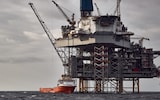Britain will be more reliant than ever on imported power to keep the lights on this winter, the National Grid has disclosed.
Other countries will supply most of the extra capacity needed to protect the UK from spells of cold and windless weather as the seasons turn according to a report from the company’s Electricity System Operator (ESO).
The biggest supplier is expected to be France.
The wrong weather can slash output from the wind and solar farms which generate an average 37pc of UK electricity.
The imminent closure of the giant Ratcliffe-on-Soar power station will also make this Britain’s first winter without any backup coal-fired generation.
ESO’s winter outlook early view says that despite such risks the UK is very unlikely to face power blackouts or other serious shortages, but this is only because of its growing capacity to import power from other countries via subsea cables.
Last year, these imports boosted UK energy security but cost the country £3bn in extra import bills – a figure expected to increase in coming years.
The move towards reliance on foreign-produced electricity is infuriating the unions representing power workers.
Andy Prendergast, the GMB union’s national secretary for the private sector, said: “Every kilowatt produced abroad is a missed opportunity for UK workers.”
The ESO report said there would be around 5.6 gigawatts (GW) of spare capacity in the grid, compared with a potential maximum UK demand of about 60GW.
However, that breathing space will be provided largely by interconnector cables – not UK power sources – because they have added 6.6GW capacity to the system, the report said.
It said: “We assume that 6.6GW net imports will be available via interconnectors at times of tighter margins.
“Should it be required, the ESO can trade on the interconnectors to secure the flows required to meet peak demands. This is an important operational tool available to support security of supply.”
Interconnectors are subsea high voltage cables which allow power to flow both ways, meaning the UK can export or import energy.
Delays in the UK’s nuclear programme and wind farm roll-out mean the flow is mostly one-way and likely to remain so for years to come.
The existing connectors include cables linking the UK to the Netherlands, Belgium, Denmark, Norway and two links to France.
Over the last year the UK has imported nearly 10pc of its total electricity, equal to about 24,000 gigawatt-hours. Over half of this has come from France.
Government data shows that power imports cost the nation around £3bn in 2023, with nearly half paid to France’s state-owned EDF for electricity generated in French nuclear power stations.
EDF is also building the UK’s much-delayed Hinkley Point C nuclear power station.
Mr Prendergast said: “We understand the need for contingency plans to import power in times of shortage but reliance on imports is becoming the default.
“This is down to successive governments failing to plan for energy and letting down the nation and its power workers.”
The longest subsea cable, to Denmark, stretches nearly 500 miles. The newest runs from Blyth in Northumberland to the Norwegian village of Kvilldal, enabling imports of low-carbon electricity generated by Norway’s hydroelectric plants.
Together they have a capacity of 11.7GW in operation or under construction – enough for about 14 million homes.
Two more planned cables, LionLink (to Holland) and Tarchon (to Germany) could add a further 3.2GW – equivalent to four million homes.
National Grid, which owns six of the UK’s nine interconnectors, and which profits from the trade in power, has said the cables prevented 12 potential blackouts in 2023.
ESO said: “We expect to have sufficient operational surplus throughout winter even when we consider the expected natural variation of demand, wind and outages.
“As with previous winters, there may be some tight days where we need to use our standard operational tools, including the use of system notices [when heavy users are incentivised to cut power consumption].
“The year-on-year change is due to increased interconnector capacity, new gas generation, growth in battery storage capacity and the effects of increased generation.”
Mel Evans, Greenpeace UK climate team leader, said: “It’s fantastic to see that sharing renewable electricity with [countries like] Denmark is working so well.
“So imagine how much more secure our supply would be if we shared more with other nations, had more storage on the grid, and brought more offshore wind online.”
Under the most ambitious interconnector scheme, the Xlinks project, now in planning, four 2,500-mile cables would be laid from the UK to Morocco, connecting with solar and wind farms built in the Sahara desert.
The £20bn scheme would provide as much electricity as Hinkley Point C.
Disclaimer: The copyright of this article belongs to the original author. Reposting this article is solely for the purpose of information dissemination and does not constitute any investment advice. If there is any infringement, please contact us immediately. We will make corrections or deletions as necessary. Thank you.



